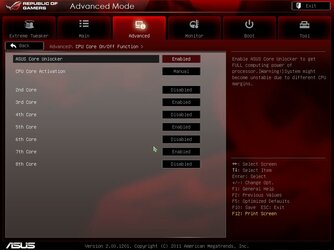For the purposes of this conversation, I'd like to hold piledriver and bulldozer equivalent if thats ok.
Notes ->
All tests were complete 5 times with the exception of R15 single core, which was ran 3 times. Averages of scores were taken. CPU is an fx 8320 on a sabertooth 990fx, running 1600mhz ram at stock speeds (only multiplier was touched. Turbo, APM, and other power saving devices were disabled). Super pi ran WITHOUT any modifications.
I ran valley, but the scores wound up being erroneous as the data sets seem to be a much wider range unfortunately.
This is observational data only. Ive only seen singular data on core count,without consideration to the modules or architecture used on these cpu's.
8 cores 4 modules
---------------------
- Geekbench 3 32bit 2134 single core/11404 multi core
- super pi 1m 22.651 seconds
- R15 multi score 638
- R15 single core 95
4 cores 2 modules
---------------------
- Geekbench 3 32bit 2114 single core/6217 multi core
- super pi 1m 22.500 seconds
- R15 multi core 318
- R15 single core 95
4 cores 4 modules
---------------------
- Geekbench 3 32bit 2067 single core/6081 multi core
- super pi 1m 23.17 seconds
- R15 multi core 303
- R15 single core 90
Obviously the 8c/4m was simply a baseline.
Gains from 4c/4m to 4c/2m was ->
2.27% for single core geekbench
2.23% for multi core geekbench
2.97% for super pi 1m
4.95% for R15 multi core
5.55% for R15 single core
Again, purely observational data. Results weren't surprising, but most likely impossible to differentiate in day to day tasking. R15 CLEARLY favored the paired modules vs the independent cores. Im also under the impression, you are able to clock higher having 1 core per module, which would obviously offset the difference for sure.
Notes ->
All tests were complete 5 times with the exception of R15 single core, which was ran 3 times. Averages of scores were taken. CPU is an fx 8320 on a sabertooth 990fx, running 1600mhz ram at stock speeds (only multiplier was touched. Turbo, APM, and other power saving devices were disabled). Super pi ran WITHOUT any modifications.
I ran valley, but the scores wound up being erroneous as the data sets seem to be a much wider range unfortunately.
This is observational data only. Ive only seen singular data on core count,without consideration to the modules or architecture used on these cpu's.
8 cores 4 modules
---------------------
- Geekbench 3 32bit 2134 single core/11404 multi core
- super pi 1m 22.651 seconds
- R15 multi score 638
- R15 single core 95
4 cores 2 modules
---------------------
- Geekbench 3 32bit 2114 single core/6217 multi core
- super pi 1m 22.500 seconds
- R15 multi core 318
- R15 single core 95
4 cores 4 modules
---------------------
- Geekbench 3 32bit 2067 single core/6081 multi core
- super pi 1m 23.17 seconds
- R15 multi core 303
- R15 single core 90
Obviously the 8c/4m was simply a baseline.
Gains from 4c/4m to 4c/2m was ->
2.27% for single core geekbench
2.23% for multi core geekbench
2.97% for super pi 1m
4.95% for R15 multi core
5.55% for R15 single core
Again, purely observational data. Results weren't surprising, but most likely impossible to differentiate in day to day tasking. R15 CLEARLY favored the paired modules vs the independent cores. Im also under the impression, you are able to clock higher having 1 core per module, which would obviously offset the difference for sure.
Last edited:

 That is exactly my point and why I asked...
That is exactly my point and why I asked...